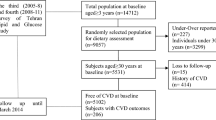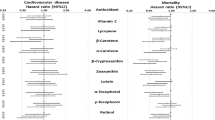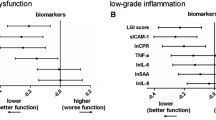Abstract
Background: Endothelial cell dysfunction may be related to an increase in cellular oxidative stress. Carotenoids and vitamins could have an antioxidant-mediated tempering influence on endothelial function and inflammation, thereby reducing the risk of atherosclerosis. Methods: We measured serum carotenoids, α$-tocopherol and Vitamin C concentrations in 379 subjects sampled from the general population. High-sensitive C-reactive protein (CRP), fibrinogen (Fbg) and leukocytes were measured as markers of inflammation. Furthermore, soluble intercellular adhesion molecule-1 (sICAM-1) and flow-mediated vasodilation (FMD; n=165) were measured as markers of endothelial function. Relationships between serum carotenoids and vitamins and markers of endothelial function and inflammation were analysed after adjustment for confounding. Results: In the total study group, lutein and lycopene were inversely related to sICAM-1 with regression-coefficients of −0.38 $±$ 0.19 (p=0.04) and −0.16 $±$ 0.08 (p=0.04) per 1 μmol/l, respectively. $β$-Carotene was inverse related to leukocytes (−0.23 $±$ 0.07; p=0.007) and CRP (−1.09 ± 0.30; p=0.0003) per 1 $μ$mol/l. Vitamin C was inverse related to CRP (−0.01 $±$ 0.005; p=0.04) per 1 $μ$mol/l, whereas $α$-tocopherol was positively related to CRP (0.03 $±$ 0.01; p=0.02) per 1 $μ$/l. Zeaxanthin was inversely related to FMD (31.2 $±$ 15.3; p=0.04) per 1 $μ$mol/l. Conclusion: The inverse relations between carotenoids, Vitamin C and sICAM-1, CRP and leukocytes may help to explain the possible protective effect of carotenoids and Vitamin C on atherosclerosis through an influence on inflammatory processes and endothelial function.
Similar content being viewed by others
References
Brown AA, Hu FB. Dietary modulation of endothelial function: Implications for cardiovascular disease. Am J Clin Nutr 2001; 73: 673–686.
Hennig B, Toborek M. Nutrition and endothelial cell function: Implications in atherosclerosis. Nutr Res 2001; 21: 279–293.
Navab M, Imes SS, Hama SY, et al. Monocyte trans-migration induced by modification of low density lipoprotein in cocultures of human aortic wall cells is due to induction of monocyte chemotactic protein 1 synthesis and is abolished by high density lipoprotein. J Clin Invest 1991; 88: 2039–2046.
Marui N, Offermann MK, Swerlick R, et al. Vascular cell adhesion molecule-1 (VCAM-1)gene transcription and expression are regulated through an antioxidant-sensitive mechanism in human vascular endothelial cells. J Clin Invest 1993; 92: 1866–1874.
Berliner JA, Navab M, Fogelman AM, et al. Athero-sclerosis: basic mechanisms. Oxidation, inflammation, and genetics. Circulation 1995; 91: 2488–2496.
Ross R. Atherosclerosis–an in. inflammatory disease. N Engl J Med 1999; 340: 115–126.
Gey KF, Sta ¨helin HB, Eichholzer M. Poor plasma status of carotene and Vitamin C is associated with higher mortality from ischemic heart disease and stroke: Basal prospective study. Clin Invest 1993; 71: 3–6.
Kardinaal AF, Kok FJ, Ringstad J, et al. Antioxidants in adipose tissue and risk of myocardial infarction: The EURAMIC study. Lancet 1993; 342: 1379–1384.
Street DA, Comstock GW, Salkeld RM, Schüep W, Klag MJ. Serum antioxidants and myocardial infarc-tion: Are low levels of carotenoids and a tocopherol risk factors for myocardial infarction? Circulation 1994; 90: 1154–1161.
Curran FJ, Sattar N, Talwar D, Baxter JN, Imrie CW. Relationship of carotenoid and Vitamins A and E with the acute inflatammatory response in acute pancreatitis. Br J Surg 2000; 87: 301–305.
Erlinger TP, Guallar E, Miller ER, Stolzenberg-Solo-mon R, Appel LJ. Relationship between systemic markers of inflatammation and serum beta-carotene levels. Arch Int Med 2001; 161: 1903–1908.
Celermajer DS, Sorensen KE, Bull C, Robinson J, Deanfield JE. Endothelium-dependent dilation in the systemic arteries of asymptomatic subjects relates to coronary risk factors and their interaction. J Am Coll Cardiol 1994, 24: 1468–1474.
Demerath E, Towne B, Blangero J, Siervogel RM. The relationship of soluble ICAM-1, VCAM-1, P-selectin and E-selectin to cardiovascular disease risk factors in healthy men and women. Ann Hum Biol 2001; 28: 664–678.
Ridker PM, Hennekes CH, Buring JE, Rifai N. C-reactive protein and other markers of inflammation in the prediction of cardiovascular disease in women. N Engl J Med 2000; 342: 836–843.
Blankenberg S, Rupprecht HJ, Bickel C, et al. Circu-lating cell adhesion molecules and death in patients with coronary artery disease. Circulation 2001; 104: 1336–1342.
Danesh J, Collins R, Appleby P, Peto R. Association of brinogen, C-reactive protein, albumin, or leukocyte count with coronary heart disease: Meta-analyses of prospective studies. JAMA 1998; 279: 1477–1482.
Tracy RP. Epidemiological evidence for inflammation in cardiovascular disease. Thromb Haemost 1999; 82: 826–831.
Broekmans WMR, Klopping-Ketelaars IAA, West-strate JA, et al. Decreased carotenoid concentrations due to dietary sucrose polyesters do not affect possible markers of disease risk in humans. J Nutr 2003; 133: 720–726.
Friedewald WT, Levy RI, Fredrickson DS. Estimation of the concentration of low-density lipoprotein cho-lesterol in plasma, without use of the preparative ultracentrifuge. Clin Chem 1972; 18: 499–502.
Clauss A. Gerinnungsphysiologische Schnellmethode zur Bestimmung des Fibrinogens. Acta Haemat 1957; 17: 237–246.
De Maat MP, De Bart AC, Hennis BC, et al. Interin-dividual and intraindividual variability in plasma brinogen, TPA antigen, PAI activity, and CRP in healthy, young volunteers and patients with angina pectoris. Arterioscler Thromb Vasc Biol 1996; 16: 1156–1162.
Gearing AJ, Hemingway I, Pigott R, Hughes J, Rees AJ, Cashman SJ. Soluble forms of vascular adhesion molecules, E-selectin, ICAM-1, and VCAM-1: Pathological signi cance. Ann NY Acad Sci 1992; 667: 324–331.
De Roos NM, Bots ML, Katan MB. Replacement of dietary saturated fatty acids by trans fatty acids lowers serum HDL cholesterol and impairs endothelial func-tion in healthy men and women. Arterioscler Thromb Vasc Biol 2001; 21: 1233–1237.
Rothman KJ, Greenland S. Precision and validity of epidemiological studies. In: Rothman KJ, Greenland S (eds), Modern epidemiology, Philadelphia, USA: Lippincott-Raven, 1998; 115–134.
Martin KR, Wu D, Meydani M. The effect of carote-noids on the expression of cell surface adhesion mole-cules and binding of monocytes to human aortic endothelial cells. Atherosclerosis 2000; 150: 265–274.
Wu D, Koga T, Martin KR, Meydani M. Effect of Vitamin E on human aortic endothelial cell production of chemokines and adhesion to monocytes. Athero-sclerosis 1999; 147: 297–307.
Rissanen TH, Voutilainen S, Nyyssonen K, et al. Low serum lycopene concentration is associated with an excess incidence of acute coronary events and stroke: The Kuopio ischaemic heart disease risk factor study. Br J Nutr 2001; 85: 749–754.
Kohlmeier L, Kark JD, Gomez-Gracia E, et al. Lyco-pene and myocardial infarction risk in the EURAMIC study. Am J Epidemiol 1997; 146: 618–626.
Rissanen T, Voutilainen S, Nyyssonen K, Salonen R, Salonen JT. Low plasma lycopene concentration is associated with increased intima-media thickness of the carotid artery wall. Arterioscler Thromb Vasc Biol 2000; 20: 2677–2681.
Dwyer JH, Navab M, Dwyer KM, et al. Oxygenated carotenoid lutein and progression of early atheroscle-rosis: The Los Angeles atherosclerosis study. Circula-tion 2001; 103: 2922–2927.
Ridker PM, Hennekens CH, Roitman-Johnson B, Stampfer M, Allen J. Plasma concentration of soluble intercellular adhesion molecule 1 and risks of future myocardial infarction in apparently healthy men. Lancet 1998; 351: 88–92.
Malik I, Danesh J, Whincup P, et al. Soluble adhesion molecules and prediction of coronary heart disease: A prospective study and meta-analysis. Lancet 2001; 358: 971–976.
Ridker PM. Role of inflammatory biomarkers in pre-diction of coronary heart disease. Lancet 2001; 358: 946–948.
De Maat MP, Pijl H, Kluft C, Princen HM. Con-sumption of black and green tea had no effect on inflammation, haemostatis and endothelial markers in smoking healthy individuals. Eur J Clin Nutr 2000; 54: 757–763.
Kritchevsky SB, Bush AJ, Pahor M, Gross MD. Serum carotenoids and markers of inflammation in non-smokers. Am J Epidemiol 2000; 152: 1065–1071.
Kritchevsky SB. b Carotene, carotenoids and the prevention of coronary heart disease. J Nutr 1999; 129: 5–8.
Lee IM, Cook NR, Manson JE, Buring JE, Hennekens CH. b Carotene supplementation and incidence of cancer and cardiovascular disease: The women 's health study. J Natl Cancer Inst 1999; 91: 2102–2106.
Omenn GS, Goodman GE, Thronquist MD, et al. Effects of a combination of b carotene and vitamin A on lung cancer and cardiovascular disease. N Engl J Med 1996; 664: 1150–1155.
Heart Protection Study Collaborative Group. MRC/ BHF heart protection study of antioxidant vitamin supplementation in 20, 536 high-risk individuals: A randomised placebo-controlled trial. Lancet 2002; 360: 23–33.
Author information
Authors and Affiliations
Rights and permissions
About this article
Cite this article
van Herpen-broekmans, W., Klöpping-ketelaars, I., Michiel, B. et al. Serum carotenoids and vitamins in relation to markers of endothelial function and inflammation. Eur J Epidemiol 19, 915–921 (2004). https://doi.org/10.1007/s10654-004-5760-z
Issue Date:
DOI: https://doi.org/10.1007/s10654-004-5760-z




